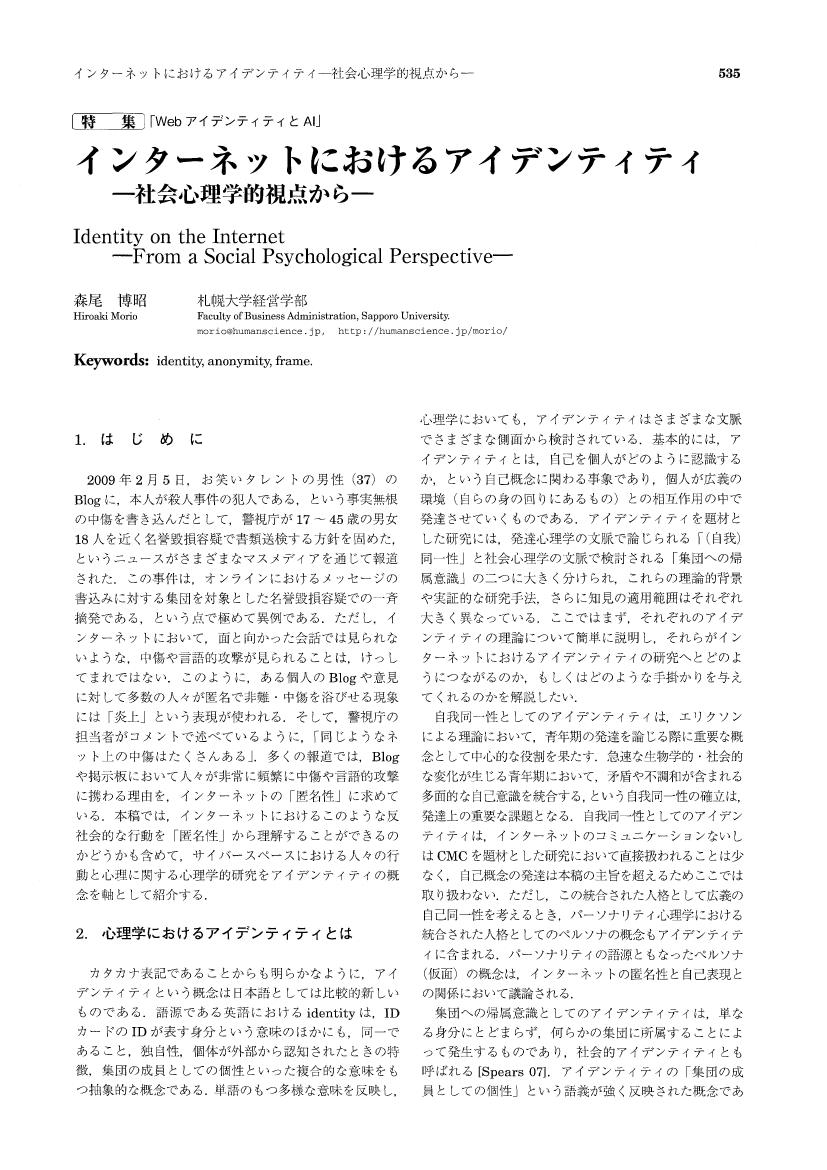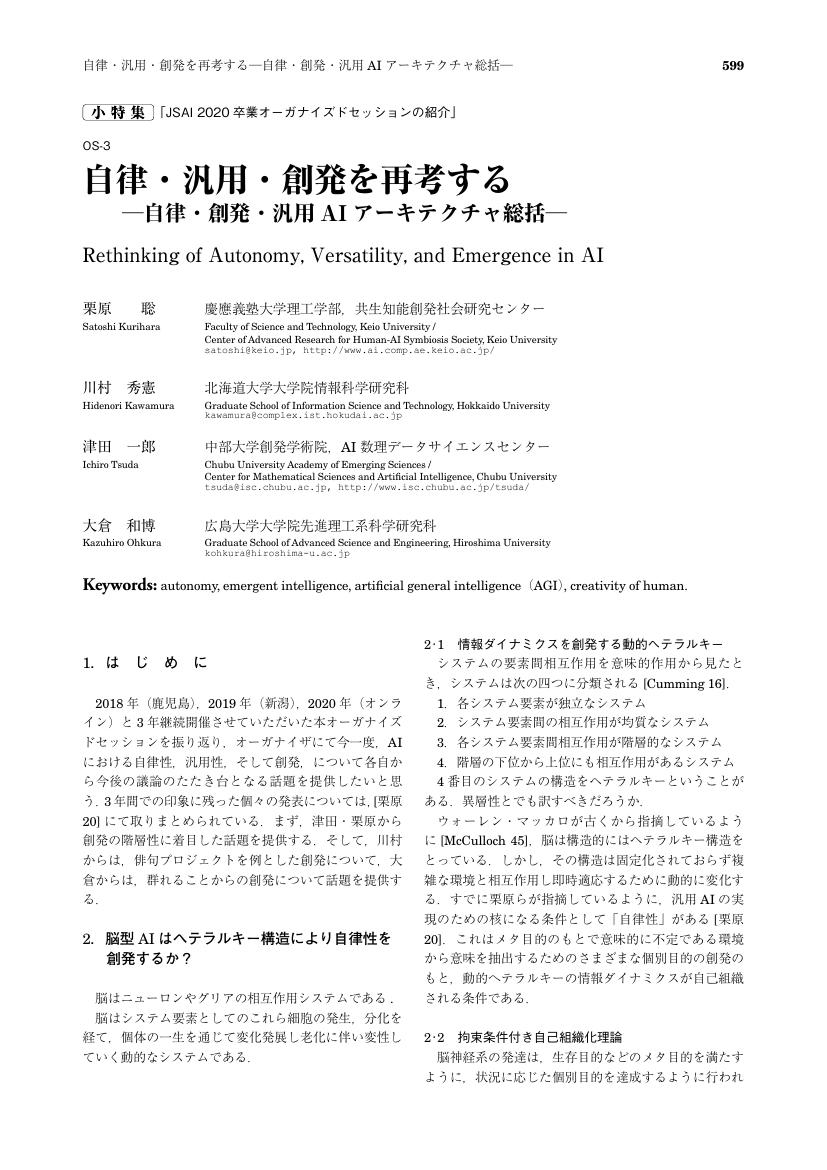1 0 0 0 OA 客体化学習の検討
- 著者
- 山川 宏
- 出版者
- 一般社団法人 人工知能学会
- 雑誌
- 人工知能学会全国大会論文集 第35回 (2021)
- 巻号頁・発行日
- pp.1H2GS1a01, 2021 (Released:2021-06-14)
人工知能が思考の幅を大きく広げ、科学的発見につながる創造能力を獲得するには、帰納的推論の枠組みである整列構造を自律的に発見できなければならない。本研究では、整列構造を支える3種類の関係を自動的に構築する方法を目指す。指定関係とその等価性は、計算処理によって様々な方法で構成できると仮定しうることが明らかになった。しかし、比較可能性についてはセンサの特性から得るしか無い。そこで、センサの比較可能性に合致するように様々な指定関係を組み合わせて、新たな整列構造を得る手段を検討した。すると、それは、対象を認識・操作しやすいモノとして扱う意味での「客体化」とみなせることがわかった。そして現在進呈している深層生成モデルの中で特にアテンション機能を備えたモデルは、整列構造に基づいて客体を学習する実現要件を満たしつつある。しかしながら新たな客体化を学習することは未だ難しさが残るようである。
1 0 0 0 OA エピソード記憶と価値を紐づけた海馬モデルによる行動学習の分析
- 著者
- 堤 優奈 栢沼 晋太郎 川添 紗奈 宮田 真宏 大森 隆司
- 出版者
- 一般社団法人 人工知能学会
- 雑誌
- 人工知能学会第二種研究会資料 (ISSN:24365556)
- 巻号頁・発行日
- vol.2018, no.AGI-008, pp.03, 2018-03-20 (Released:2021-09-16)
Episodic memory is the important function of hippocampus, and we can't lack it for our wholesome life. But its theory and role in decision making is not clear yet. In this study, we analyze and discuss on its model that we proposed at the WBAI hackathon. As the result, an association of the episodes and the value enabled rapid action learning with small number of experiences, and takes complementary role with the strong but slow feature of Deep Learning.
- 著者
- 和地 瞭良 宮口 航平
- 出版者
- 一般社団法人 人工知能学会
- 雑誌
- 人工知能 (ISSN:21882266)
- 巻号頁・発行日
- vol.37, no.3, pp.389-390, 2022-05-01 (Released:2022-05-01)
- 著者
- 森尾 博昭
- 出版者
- 一般社団法人 人工知能学会
- 雑誌
- 人工知能 (ISSN:21882266)
- 巻号頁・発行日
- vol.24, no.4, pp.535-543, 2009-07-01 (Released:2020-09-29)
1 0 0 0 OA 深層学習におけるバックドア攻撃に対する蒸留を用いた対策とポイズンデータの特定
- 著者
- 吉田 康太 藤野 毅
- 出版者
- 一般社団法人 人工知能学会
- 雑誌
- 人工知能学会全国大会論文集 第34回 (2020)
- 巻号頁・発行日
- pp.4J3GS204, 2020 (Released:2020-06-19)
深層学習(DNN)システムにおけるセキュリティ課題として,バックドア攻撃が知られている.画像認識におけるバックドア攻撃では,攻撃者はDNNモデルの学習データセットに,特定位置へのドット付与などの目立たない加工を施し,加工前とは異なるターゲットラベルを設定した少量の異常データ(ポイズンデータ)を混入させる.このデータセットを用いて学習したDNNモデル(バックドアモデル)は,正常な入力に対しては正常に推論を行うが,ポイズンデータと同様の加工が施された入力に対しては,推論結果がターゲットラベルに誘導されてしまう.本稿では,DNNモデルユーザ(防御者)がラベルのないクリーンなデータを収集できるタスクを想定し,蒸留を用いたバックドア攻撃への対策を提案する.バックドアモデルを教師とし,クリーンデータを用いて蒸留することで,ポイズンデータの影響を排除した生徒モデルが得られる.更に,バックドアモデルと生徒モデルそれぞれで学習データセットを分類した時の推論結果の差分から,学習データ5万件の中に100件のみ含まれるポイズンデータの候補を約550件まで絞り込むことができる.
- 著者
- 藤原 吏生 岸波 洋介 今野 颯人 佐藤 志貴 佐藤 汰亮 宮脇 峻平 加藤 拓真 鈴木 潤 乾 健太郎
- 出版者
- 一般社団法人 人工知能学会
- 雑誌
- 人工知能学会研究会資料 言語・音声理解と対話処理研究会 90回 (2020/11) (ISSN:09185682)
- 巻号頁・発行日
- pp.25, 2020-11-24 (Released:2021-06-12)
1 0 0 0 OA 相槌の特徴に一致した頷き生成モデル
- 著者
- 森 大河 伝 康晴
- 出版者
- 一般社団法人 人工知能学会
- 雑誌
- 人工知能学会論文誌 (ISSN:13460714)
- 巻号頁・発行日
- vol.37, no.3, pp.IDS-H_1-12, 2022-05-01 (Released:2022-05-01)
- 参考文献数
- 38
In human-human interactions, a listener uses both verbal tokens and head nods for responding signals, and they frequently co-occur. When humanoid robots and anthropomorphic agents response to a user using verbal tokens and head nods simultaneously, they must be generated in proper timing to each other and have consistent features. In this paper, we propose models to predict co-occurrence and physical features of head nods based on prosodic and syntactic features of verbal response tokens. We used, as predictive variables, the forms, positions, durations, averages/standard deviations of fundamental frequency and loudness of response tokens and head positions at the beginning of response tokens. In addition, considering participation framework, we also used speaker's gaze and listener's gaze at the beginning of response tokens, and applied generalized mixed models to predict the co-occurrence, type, range, repetition and velocity of head nods. The results confirmed that proposed models can predict these outcomes effectively.
- 著者
- 三野 星弥 吉川 雄一郎 伴 碧 石黒 浩
- 出版者
- 一般社団法人 人工知能学会
- 雑誌
- 人工知能学会論文誌 (ISSN:13460714)
- 巻号頁・発行日
- vol.37, no.3, pp.IDS-I_1-14, 2022-05-01 (Released:2022-05-01)
- 参考文献数
- 39
- 被引用文献数
- 2
The goal of this study is to realize a non-task-oriented dialogue agent that is accepted by people in the long term. One approach is using a dialogue strategy in which an agent shares information about other users who are not participating in the current dialogue. This study aims to develop a chatbot that is capable of sharing information about others and to examine its usefulness as well as its problems such as privacy concerns using a long-term empirical experiment in a real-world environment. The result of a 14-day experiment with 120 participants suggested that the usefulness of this dialogue strategy lies in its ability to maintain users’ motivation to interact with the agent and prevent them from having the impression that the agent is mechanical. However, irrespective of the presence of this dialogue strategy, it was suggested that the users were concerned about their privacy to the agent that collected their information on a daily basis. Based on these results, we discussed the relationship between the interestingness of the shared information and the users’ privacy concerns.
1 0 0 0 OA 藤原幸一:スモールデータ解析と機械学習,pp. 296,オーム社(2022)
- 著者
- 清田 陽司
- 出版者
- 一般社団法人 人工知能学会
- 雑誌
- 人工知能 (ISSN:21882266)
- 巻号頁・発行日
- vol.37, no.3, pp.393-394, 2022-05-01 (Released:2022-05-01)
1 0 0 0 OA 対話穴埋め:検索・生成ベース雑談対話システムの発話制御手法
- 著者
- 薛 強 滝口 哲也 有木 康雄
- 出版者
- 一般社団法人 人工知能学会
- 雑誌
- 人工知能学会論文誌 (ISSN:13460714)
- 巻号頁・発行日
- vol.37, no.3, pp.IDS-C_1-9, 2022-05-01 (Released:2022-05-01)
- 参考文献数
- 16
Generation-base dialogue system tends to produce generic response sentences. In order to improve the diversity of response sentences by the generation-base dialogue system, the response text retrieved by the retrieval-base model can be input to the generation-base model as reference response text, so that the generation-base model can generate highly diverse response sentences. However, the prior works show that the generation-base dialogue system often ignores the reference response text, resulting in the response sentences that is unrelated to the reference response text. In this work, we propose the Dialogue-Filling method, which can utilize 100% of the reference response text by masking the response sentences with a text-filling technique. We built variants of Dialogue-Filling method with DialoGPT model. Experiments on the DailyDialog Dataset demonstrate that our Dialogue-Filling method outperforms the baseline method on the dialogue generation task.
1 0 0 0 OA 論文特集:「知的対話システム」論文特集「知的対話システム」にあたって
- 著者
- 藤江 真也 船越 孝太郎
- 出版者
- 一般社団法人 人工知能学会
- 雑誌
- 人工知能 (ISSN:21882266)
- 巻号頁・発行日
- vol.37, no.3, pp.363, 2022-05-01 (Released:2022-05-01)
- 著者
- 宮本 友樹 永井 望 満田 雄斗 磐下 大樹 遠藤 水紀 鈴木 章弘 片上 大輔
- 出版者
- 一般社団法人 人工知能学会
- 雑誌
- 人工知能学会論文誌 (ISSN:13460714)
- 巻号頁・発行日
- vol.37, no.3, pp.IDS-G_1-16, 2022-05-01 (Released:2022-05-01)
- 参考文献数
- 37
In this paper, we propose the “Risky Politeness Strategy (RPS)” as a framework of utterance strategy focusing on risk-taking in dialogue systems. In previous research, it has been reported that it is useful to implement politeness strategies that have risks such as jokes and compliments in dialogue systems. On the other hand, a design theory for effectively implementing risk-taking utterance strategies in dialogue systems has not been established. Against this background, we defined RPS with reference to politeness/impoliteness research in the fields of linguistics. In addition, we developed a rule-based dialogue system and an example-based dialogue system to implement the RPS in a non-task-oriented dialogue. User evaluations were conducted through the preliminary rounds of the Dialogue System Live Competition 2 and 3. The results of the user evaluations showed that the rule-based and example-based RPS-speaking non-task-oriented dialogue systems were able to engage in dialogue that was evaluated by the user as having humanity. Therefore, the usefulness of implementing RPS in non-task-oriented dialogue systems has been shown at a certain level.
1 0 0 0 OA 人工知能研究会/AIR
- 著者
- 佐久間 洋司 石黒 浩
- 出版者
- 一般社団法人 人工知能学会
- 雑誌
- 人工知能 (ISSN:21882266)
- 巻号頁・発行日
- vol.32, no.2, pp.264-265, 2017-03-01 (Released:2020-09-29)
1 0 0 0 OA OS-3自律・汎用・創発を再考する —自律・創発・汎用 AIアーキテクチャ総括—
- 著者
- 栗原 聡 川村 秀憲 津田 一郎 大倉 和博
- 出版者
- 一般社団法人 人工知能学会
- 雑誌
- 人工知能 (ISSN:21882266)
- 巻号頁・発行日
- vol.36, no.5, pp.599-604, 2021-09-01 (Released:2021-09-01)
- 著者
- 國藤 進
- 出版者
- 一般社団法人 人工知能学会
- 雑誌
- 人工知能 (ISSN:21882266)
- 巻号頁・発行日
- vol.14, no.1, pp.50-57, 1999-01-01 (Released:2020-09-29)
1 0 0 0 OA 人工知能研究者の逆襲
- 著者
- 堀 浩一
- 出版者
- 一般社団法人 人工知能学会
- 雑誌
- 人工知能 (ISSN:21882266)
- 巻号頁・発行日
- vol.15, no.5, pp.749, 2000-09-01 (Released:2020-09-29)
- 著者
- 村上 陽一郎 辻井 潤一 金田 伊代 清田 陽司 三宅 陽一郎 大内 孝子
- 出版者
- 一般社団法人 人工知能学会
- 雑誌
- 人工知能 (ISSN:21882266)
- 巻号頁・発行日
- vol.37, no.3, pp.364-375, 2022-05-01 (Released:2022-05-01)
- 著者
- 津村 賢宏 倉橋 節也 栗原 聡 佐久間 洋司 清田 陽司
- 出版者
- 一般社団法人 人工知能学会
- 雑誌
- 人工知能 (ISSN:21882266)
- 巻号頁・発行日
- vol.37, no.3, pp.334-337, 2022-05-01 (Released:2022-05-01)
- 著者
- 黒田 彗莉 山川 宏 鳥海 不二夫 佐久間 洋司 清田 陽司
- 出版者
- 一般社団法人 人工知能学会
- 雑誌
- 人工知能 (ISSN:21882266)
- 巻号頁・発行日
- vol.37, no.3, pp.329-333, 2022-05-01 (Released:2022-05-01)
1 0 0 0 OA 特集:「スマートファクトリーとAI」特集「スマートファクトリーとAI」にあたって
- 著者
- 山本 泰生 牛久 祥孝 西岡 靖之
- 出版者
- 一般社団法人 人工知能学会
- 雑誌
- 人工知能 (ISSN:21882266)
- 巻号頁・発行日
- vol.37, no.3, pp.252, 2022-05-01 (Released:2022-05-01)





